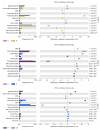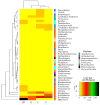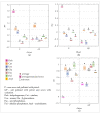Microbiological Study in Petrol-Spiked Soil
- PMID: 34062889
- PMCID: PMC8125633
- DOI: 10.3390/molecules26092664
Microbiological Study in Petrol-Spiked Soil
Abstract
The pollution of arable lands and water with petroleum-derived products is still a valid problem, mainly due the extensive works aimed to improve their production technology to reduce fuel consumption and protect engines. An example of the upgraded fuels is the BP 98 unleaded petrol with Active technology. A pot experiment was carried out in which Eutric Cambisol soil was polluted with petrol to determine its effect on the microbiological and biochemical properties of this soil. Analyses were carried out to determine soil microbiome composition-with the incubation and metagenomic methods, the activity of seven enzymes, and cocksfoot effect on hydrocarbon degradation. The following indices were determined: colony development index (CD); ecophysiological diversity index (EP); index of cocksfoot effect on soil microorganisms and enzymes (IFG); index of petrol effect on soil microorganisms and enzymes (IFP); index of the resistance of microorganisms, enzymes, and cocksfoot to soil pollution with petrol (RS); Shannon-Weaver's index of bacterial taxa diversity (H); and Shannon-Weaver's index of hydrocarbon degradation (IDH). The soil pollution with petrol was found to increase population numbers of bacteria and fungi, and Protebacteria phylum abundance as well as to decrease the abundance of Actinobacteria and Acidobacteria phyla. The cultivation of cocksfoot on the petrol-polluted soil had an especially beneficial effect mainly on the bacteria belonging to the Ramlibacter, Pseudoxanthomonas, Mycoplana, and Sphingobium genera. The least susceptible to the soil pollution with petrol and cocksfoot cultivation were the bacteria of the following genera: Kaistobacter, Rhodoplanes, Bacillus, Streptomyces, Paenibacillus, Phenylobacterium, and Terracoccus. Cocksfoot proved effective in the phytoremediation of petrol-polluted soil, as it accelerated hydrocarbon degradation and increased the genetic diversity of bacteria. It additionally enhanced the activities of soil enzymes.
Keywords: degradation hydrocarbons; microbial diversity; petrol; phytoremediation; soil; soil enzymes.
Conflict of interest statement
The authors declare no conflict of interest. The funders had no role in the design of the study; in the collection, analyses, or interpretation of data; in the writing of the manuscript, or in the decision to publish the results.
Figures










Similar articles
-
The Role of Dactylis Glomerata and Diesel Oil in the Formation of Microbiome and Soil Enzyme Activity.Sensors (Basel). 2020 Jun 13;20(12):3362. doi: 10.3390/s20123362. Sensors (Basel). 2020. PMID: 32545819 Free PMC article.
-
Implications of Soil Pollution with Diesel Oil and BP Petroleum with ACTIVE Technology for Soil Health.Int J Environ Res Public Health. 2019 Jul 11;16(14):2474. doi: 10.3390/ijerph16142474. Int J Environ Res Public Health. 2019. PMID: 31336741 Free PMC article.
-
Response of soil microorganisms and enzymes to the foliar application of Helicur 250 EW fungicide on Horderum vulgare L.Chemosphere. 2020 Mar;242:125163. doi: 10.1016/j.chemosphere.2019.125163. Epub 2019 Oct 23. Chemosphere. 2020. PMID: 31677518
-
The role of microorganisms in petroleum degradation: Current development and prospects.Sci Total Environ. 2023 Mar 20;865:161112. doi: 10.1016/j.scitotenv.2022.161112. Epub 2022 Dec 28. Sci Total Environ. 2023. PMID: 36586680 Review.
-
[Advances in biodegradation of petroleum hydrocarbons].Sheng Wu Gong Cheng Xue Bao. 2021 Aug 25;37(8):2765-2778. doi: 10.13345/j.cjb.200611. Sheng Wu Gong Cheng Xue Bao. 2021. PMID: 34472294 Review. Chinese.
Cited by
-
Mitigation of the Adverse Impact of Copper, Nickel, and Zinc on Soil Microorganisms and Enzymes by Mineral Sorbents.Materials (Basel). 2022 Jul 27;15(15):5198. doi: 10.3390/ma15155198. Materials (Basel). 2022. PMID: 35955133 Free PMC article.
-
Evaluation of the Usefulness of Sorbents in the Remediation of Soil Exposed to the Pressure of Cadmium and Cobalt.Materials (Basel). 2022 Aug 19;15(16):5738. doi: 10.3390/ma15165738. Materials (Basel). 2022. PMID: 36013875 Free PMC article.
-
Revitalization of Soil Contaminated by Petroleum Products Using Materials That Improve the Physicochemical and Biochemical Properties of the Soil.Molecules. 2024 Dec 11;29(24):5838. doi: 10.3390/molecules29245838. Molecules. 2024. PMID: 39769927 Free PMC article.
-
Effects of Tebuconazole Application on Soil Microbiota and Enzymes.Molecules. 2022 Nov 3;27(21):7501. doi: 10.3390/molecules27217501. Molecules. 2022. PMID: 36364328 Free PMC article.
-
Role of Different Material Amendments in Shaping the Content of Heavy Metals in Maize (Zea mays L.) on Soil Polluted with Petrol.Materials (Basel). 2022 Apr 2;15(7):2623. doi: 10.3390/ma15072623. Materials (Basel). 2022. PMID: 35407954 Free PMC article.
References
-
- Erisman J.W., van Eekeren N., De Wit J., Koopmans C.J., Cuijpers W.J.M., Oerlemans N., Koks B. Agriculture and biodiversity: A better balance benefits both. AIMS Agric. Food. 2016;1:157–174. doi: 10.3934/agrfood.2016.2.157. - DOI
-
- Huera-Lucero T., Labrador-Moreno J., Blanco-Salas J., Ruiz-Téllez T. A framework to incorporate biological soil quality indicators into assessing the sustainability of territories in the Ecuadorian Amazon. Sustainability. 2020;12:3007. doi: 10.3390/su12073007. - DOI
-
- Odukoya J., Lambert R., Sakrabani R. Understanding the impacts of crude oil and its induced abiotic stresses on agrifood production: A Review. Horticulturae. 2019;5:47. doi: 10.3390/horticulturae5020047. - DOI
-
- Kumar A., Kumar A., da Silva Cabral Pinto M.-M., Chaturvedi A.K., Shabnam A.A., Subrahmanyam G., Mondal R., Gupta D.K., Malyan S.K., Kumar S.S., et al. Lead toxicity: Health hazards, influence on food chain, and sustainable remediation approaches. Int. J. Environ. Res. Public Health. 2020;17:2179. doi: 10.3390/ijerph17072179. - DOI - PMC - PubMed
MeSH terms
Substances
Grants and funding
LinkOut - more resources
Full Text Sources
Medical
Miscellaneous

